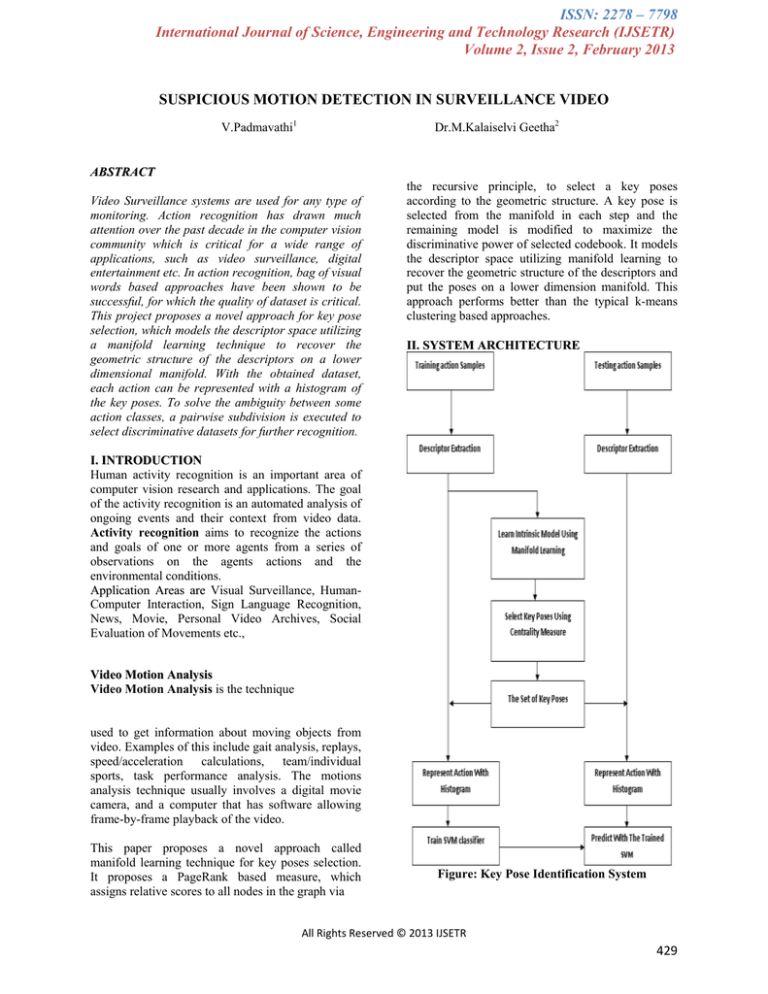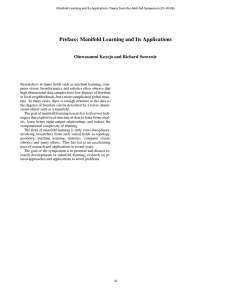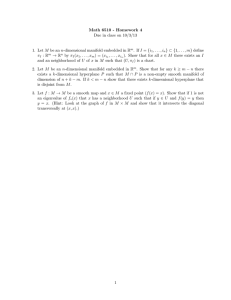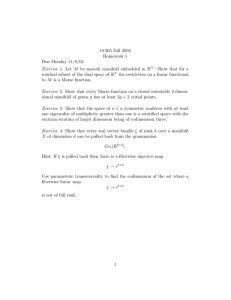
ISSN: 2278 – 7798
International Journal of Science, Engineering and Technology Research (IJSETR)
Volume 2, Issue 2, February 2013
SUSPICIOUS MOTION DETECTION IN SURVEILLANCE VIDEO
V.Padmavathi1
Dr.M.Kalaiselvi Geetha2
ABSTRACT
Video Surveillance systems are used for any type of
monitoring. Action recognition has drawn much
attention over the past decade in the computer vision
community which is critical for a wide range of
applications, such as video surveillance, digital
entertainment etc. In action recognition, bag of visual
words based approaches have been shown to be
successful, for which the quality of dataset is critical.
This project proposes a novel approach for key pose
selection, which models the descriptor space utilizing
a manifold learning technique to recover the
geometric structure of the descriptors on a lower
dimensional manifold. With the obtained dataset,
each action can be represented with a histogram of
the key poses. To solve the ambiguity between some
action classes, a pairwise subdivision is executed to
select discriminative datasets for further recognition.
the recursive principle, to select a key poses
according to the geometric structure. A key pose is
selected from the manifold in each step and the
remaining model is modified to maximize the
discriminative power of selected codebook. It models
the descriptor space utilizing manifold learning to
recover the geometric structure of the descriptors and
put the poses on a lower dimension manifold. This
approach performs better than the typical k-means
clustering based approaches.
II. SYSTEM ARCHITECTURE
I. INTRODUCTION
Human activity recognition is an important area of
computer vision research and applications. The goal
of the activity recognition is an automated analysis of
ongoing events and their context from video data.
Activity recognition aims to recognize the actions
and goals of one or more agents from a series of
observations on the agents actions and the
environmental conditions.
Application Areas are Visual Surveillance, HumanComputer Interaction, Sign Language Recognition,
News, Movie, Personal Video Archives, Social
Evaluation of Movements etc.,
Video Motion Analysis
Video Motion Analysis is the technique
used to get information about moving objects from
video. Examples of this include gait analysis, replays,
speed/acceleration calculations, team/individual
sports, task performance analysis. The motions
analysis technique usually involves a digital movie
camera, and a computer that has software allowing
frame-by-frame playback of the video.
This paper proposes a novel approach called
manifold learning technique for key poses selection.
It proposes a PageRank based measure, which
assigns relative scores to all nodes in the graph via
Figure: Key Pose Identification System
All Rights Reserved © 2013 IJSETR
429
ISSN: 2278 – 7798
International Journal of Science, Engineering and Technology Research (IJSETR)
Volume 2, Issue 2, February 2013
documents of any size. The PageRank computations
require several passes, called iterations, through the
collection to adjust approximate PageRank values to
more closely reflect the theoretical true value.
III. METHODOLOGIES
1. DESCRIPTOR EXTRACTION
In this method the certain descriptors are extracted
from the action videos to catch usable information
and then a vocabulary called codebook / Data
directory is obtained from extracted descriptors.
Thus, an action can be represented as a collection of
words from the codebook and finally, a
discriminative model is build to categorize actions
into groups using the extracted descriptors.
2. KEY POSE SELECTION
In this method the descriptors have been extracted, a
compact set called codebook needs to be learned. In
order to catch the relationship between the highdimensional descriptors and find typical key poses, a
refined model for the feature space is needed. Hence
a manifold learning algorithm, which learns an
internal model of the input data and projects the highdimensional
descriptors
to
low-dimensional
manifold. The intrinsic dimension of descriptor space
is found and a dimensional reduction is made in the
modeling procedure.
3. MULTICLASS CLASSIFICATION
Here each and every frame of the action video
corresponds to a descriptor, which can be matched to
the nearest neighbor in the codebook. Thus, an action
translates to a series of words in the codebook. The
frequency of the words in the series can be
accumulated into a histogram to represent the action
and be used for recognition.
ii. MANIFOLD LEARNING
TECHNIQUE
It is a popular recent approach to nonlinear
dimensionality reduction. Algorithms described as a
function of only a few underlying parameters. The
data points are actually samples from a lowdimensional manifold that is embedded in a highdimensional space. Manifold learning algorithms
attempt to uncover the parameters in order to find a
low-dimensional representation of the data. The
features of such a data set contain much overlapping
information, it would be helpful to somehow get a
simplified, non-overlapping representation of the data
whose features are identifiable with the underlying
parameters that govern the data. This suspicion is
formalized using the idea of a manifold.
COMMON DATASETS
In this section, publicly available datasets, which are
widely used for activity recognition evaluation. It
contains 6 types of action. They are boxing, hand
clapping, hand waving, walking, running and
jogging.
4. PAIRWISE SUBDIVISION
A pairwise algorithm in which an additional
subdivision is employed for ambiguous couples. In
subdivision process, manifold learning is employed
to build special model for the given couple. Thus, the
centrality measure tends to select key poses which
catch the intrinsic difference between given couple
and form more powerful codebook for special
subdivision problem.
IV. TECHNIQUES
i. PAGERANK BASED MEASURE
PageRank is a probability distribution used to
represent the likelihood that a person randomly
clicking on links will arrive at any particular page.
PageRank can be calculated for collections of
Figure: A Sample dataset
V. RESULTS AND DISCUSSION
Motion detection is a continuous video stream. All of
them are based on comparing the current video frame
with one from the previous frames or with something
that will call background. The application supports
the following types of video sources are AVI files
and Local Capture Device
All Rights Reserved © 2013 IJSETR
430
ISSN: 2278 – 7798
International Journal of Science, Engineering and Technology Research (IJSETR)
Volume 2, Issue 2, February 2013
Eight-neighbors N8(p) of pixel p consist of the union
of N4(p) and ND(p).
1. DETECTION PROCESS
Background modeling, which resembled by a morph
filter combines the background as an overlay image,
and the current frame to decrease the difference with
the background, which can be taken as updating the
background.
Temporal variance, which is accomplished by a
Connected Component Labeling Algorithm. That
takes connected labeled pixels, which assembles a
region in the image, and combines them into object.
2. MOTION DETECTION ALGORITHM
The background to be the first frame is received, it
have no motion at all, and further process the
background by applying a Grayscale filter and a
Pixellate Filter. The pixellete filter here used to
reduce the pixels count and emphasize the overall
color distribution of the image; then the extract the
image dimensions to use in further processing. Now
the initial background image is ready.
To establish connectivity for pixels p and q can be
considered:
4-connectivity-connected if q is in N4(p);
8-connectivity-connected if q is in N8(p);
m-connectivity-connected if q is in N4(P), or if q is in
ND(P) and N4(p) ∩ N4(q)=;
3. A CONNECTED COMPONENT LABELING
ALGORITHM
Step 1: Initial labeling.
Step 2: Resolve equivalences.
To obtain transitive closure the Floyd_Warshall (FW) algorithm is used.
for j = 1 to n
for i = 1 to n
if L[i,j] = 1 then
for k = 1 to n
L[i,k] = L[1, k] OR L[j,k];
Updating The Background Image
Update the background image by moving the pixels
intensity towards the pixels, intensity of the current
frame by one level, to decrease difference with
overlay image - source image is moved towards
overlay image. The update equation is defined in the
next way:
Result = src + min( abs( ovr - src ), step ) * sign( ovr
- src )
Result - Updated background image, which will be
the background for the next frame.
src
- Current frame image.
ovr
- Current background image.
step
- The maximum amount of changes per pixel
in the source image.
BLOB Extraction And Counting
Detection of connected components between pixels
in binary images is a fundamental step in
segmentation of an image objects and regions or
blob. Each blob is assigned a unique label to separate
it from other blobs. All the pixels within a blob of
spatially connected 1's are assigned the same label. It
can be used to establish boundaries of objects,
components of regions, and to count the number of
blobs in an image. Its applications can be found in
automatic inspection, optical character recognition,
robotic vision, etc.
Figure. Equivalence relations in terms of binary
matrix.
a) Matrix before applying the F-W algorithm.
b) Matrix after applying reflexivity and the F-W
algorithm.
4.
FAST
CONNECTED
COMPONENT
LABELING ALGORITHM WORKING FLOW
The main idea in this algorithm is to divide the image
into NxM small regions. The large equivalence array
is the main bottleneck in the original algorithm, but
NxN small equivalence arrays can be found in greatly
reduced time.
The Basics
A pixel p at coordinate (x, y) has four direct
neighbors N4(p) and four diagonal neighbors ND(p).
All Rights Reserved © 2013 IJSETR
431
ISSN: 2278 – 7798
International Journal of Science, Engineering and Technology Research (IJSETR)
Volume 2, Issue 2, February 2013
Algorithm
Step 1- Divide the given image into NxN small
regions and set Total_ Index = 0
Step 2: For each region i = 1 to NxN
1- apply Step 1of the original algorithm;
2- Allocate memory for the array pointed to by
Label_List[i] as maximum no. of labels for
Region[i];
3- Use F-W algorithm resolve the equivalences
within Region[i].
4- For j=1 to size of an array for Region[i] do
Label_List[i][j] = Total_Index + Ibl
// lbl is a label to its equivalence class after equiv.
resolution .
5- Total_index= Total_index + maximum{lbl}
6- if (i > 1) then call Merge( i ):
// to update labels in bordering area between regions.
Step3: For each region i = l toNxN do
can image in Region[i] from left to right, top to
bottom and replace all local label value k with
Label_List[i][k];
In the simplest way, it takes the difference
between two frames and highlight that difference,
this method is poor in object recognition because the
difference don’t emphasize the object shape as in
Figure1.
2. Based on edge detection
The second best approach is based on edge
detection, in spite of its good shape recognition, But
its lake in speed and takes a lot of hardware resources
shows in Figure2.
3. Based On Edge Detection Using Pixellete Filter
A little enhancement in the previous
algorithm by adding a pixellete filter obtain a good
representation of the object and a fast performance,
due to the reduced number of pixels blocks to process
as seen by following figure3.
Figure: Connected Component Labeling Algorithm
Working Flow
VI. TOTAL SYSTEM RESULT
1. Based on frame difference
All Rights Reserved © 2013 IJSETR
432
ISSN: 2278 – 7798
International Journal of Science, Engineering and Technology Research (IJSETR)
Volume 2, Issue 2, February 2013
N
4
5
10
15
20
25
CPU(secs)
274.57
160.22
12.47
4.01
2.75
2.47
Using BLOB counter
After all I eliminate the bounders and replace them
by a surrounding rectangle applied to each detected
object, because the idea is to detect and track motion
not to recognize object shapes in Figure 6.4.
CONCLUSION
This paper has proposed a novel bag of words based
approach for action recognition However, manifold
learning is distinct from the methods mentioned
earlier.
In this proposed framework, manifold
learning is employed to generate the codebook. It not
only reduces the dimensionality, but also provides a
model of the descriptors on a lower dimensional
manifold. Thus, PageRank-based centrality measure
can be executed to select key poses and obtain the
final vocabulary. It is used to evaluate the extracted
descriptors. Typical nodes from different regions are
required to compose a powerful codebook.
COMPARISON OF TECHNIQUES
The Comparison of various techniques presented in
the following table. Based on edge detection using
pixellete filter gives the better result compared to
others.
Table 5.2 Comparison of techniques
REFERENCES
[1] R. Navigli and M. Lapata, “An experimental
study of graph connectivity for unsupervised
word sense disambiguation,” IEEE Trans.
Pattern Anal. Mach. Intell., Apr. 2010.
[2] J. Liu, M. Shah, B. Kuipers, S. Savarese, CrossView Action Recognition via View Knowledge
Transfer, Proceedings of the IEEE International
Conference on Computer Vision and Pattern
Recognition, 2011.
[3] Daniel Barbar´a, Maurizio Filippone, Detecting
Suspicious Behaviour in Surveillance Images,
Proceedings of the IEEE International
Conference on Computing & Processing, 2008.
[4] G Gordon2.5. Jingen Liu and Mubarak Shah,
Learning Human Actions via Information
Maximization, IEEE International Conference on
Computer Vision and Pattern Recognition
(CVPR), 2008.
[5] Jingen Liu and Mubarak Shah, Learning Human
Actions via Information Maximization, IEEE
All Rights Reserved © 2013 IJSETR
433
ISSN: 2278 – 7798
International Journal of Science, Engineering and Technology Research (IJSETR)
Volume 2, Issue 2, February 2013
International Conference on Computer Vision
and Pattern Recognition (CVPR), 2008.
[6] Mohamed, F., 2006, Integrated Motion Detection
and Tracking for Visual Surveillance Center for
Automation Research (CfAR) UoM.
[7] M Lewis, Face recognition using video clips and
mug shots, Proceedings of the Office of National
Drug Control Policy (ONDCP) International
Technical Symposium, 1995.
[8] Alan, J. Lipton, 2000, Moving target
classification and tracking from real-time video,
The Robotics Institute., Carnegie Melon
University.
[9] Collins R. T., 2000, A system for video
surveillance and monitoring, Carnegie Mellon
Univ., Pittsburgh.
[10] Hu W., 2004, A survey on visual surveillance of
object motion and behaviors, IEEE Trans. on
systems, man, and cybernetics part C:
Applications and Reviews, Vol.34, NO.3,
August.
[11] Jung-Me Park, 2001, Fast Connected
Component Labeling Algorithm Using A Divide
and Conquer Technique, Computer Science
Dept. University of Alabama.
[12] Lumia. R., Shapiro. L., 1983, A New
Connected Components Algorithm for Virtual
Memory
Computers,
Computer
Vision,
Graphics, and Image Processing.
[13]
C. Schuldt, I. Laptev, and B. Caputo,
“Recognizing human actions: A local svm
approach,” in Proc. Int. Conf. Pattern Recognit.,
2004, pp.
Dr.M.KalaiselviGeetha is working as Assoc.Prof in
the department of computer science and Engineering
at
Annamalai
University,
Chidambaram.
She
published nearly 30 papers in various Journals and
Conferences.
Her area of interests are Pattern
Recognition, Image Processing and
Artificial
Intelligence.
AUTHORS
V.Padmavathi is working as an Assistant Professor /
CSE
in
A.V.C
College
of
Engineering,
Mayiladuthurai from December 2008. Previously, she
worked as a Junior Programmer for a period of one
year in D’zine Garage, Chennai. Now she is pursuing
her M.E Computer Science in Annamalai University,
Chidambaram. . She published nearly 10 papers in
various Journals and Conferences. Her area of
interest is Object Oriented Programming, Image
Processing and Web Technology.
All Rights Reserved © 2013 IJSETR
434






